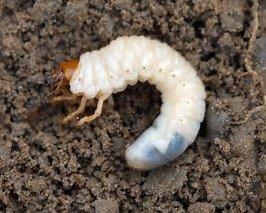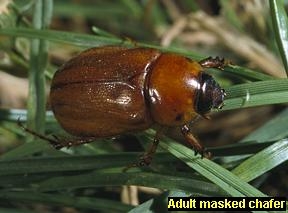Grubs Eating My Veggies?
Help for the Home Gardener from the Help Desk of the
UC Master Gardener Program of Contra Costa County

MGCC Help Desk Response: Thank you for contacting the UC Master Gardener Program Help Desk with your questions about grubs in your vegetable bed. I enjoyed talking to you today, and the picture you sent was helpful as well.
Following is some information on masked chafer grubs. http://ipm.ucanr.edu/TOOLS/TURF/PESTS/inchaf.html
Possible treatment options include hand-picking to remove any grubs you find in the soil, or turning the soil to expose grubs to birds and other predators. Beneficial nematodes can also be used for biological control of grubs, as described in the article at the following link. http://ipm.ucanr.edu/TOOLS/TURF/PESTS/innem.html
If you do remove the soil to start again (as you mentioned you might), be careful with any compost you add. The adult beetles can be attracted to fresh compost or organic matter, where they will lay their eggs. The larvae (grubs) will locate and feed on roots after they hatch. Before applying compost, be sure it had been properly prepared with sufficient heat to decompose the organic material and to kill insect eggs and other organisms. Information on rapid composting can be found at this UC link: http://anrcatalog.ucanr.edu/pdf/8037.pdf
I hope you are able to get rid of your grubs before next season. Do let us know if you have further questions.
Help Desk of the UC Master Gardener Program of Contra Costa County (TKT)
Note: The UC Master Gardeners Program of Contra Costa's Help Desk is available year-round to answer your gardening questions. Except for a few holidays, we're open every week, Monday through Thursday for walk-ins from 9:00 am to Noon at 75 Santa Barbara Road, 2d Floor, Pleasant Hill, CA 94523. We can also be reached via telephone: (925)646-6586, email: ccmg@ucanr.edu, or on the web at http://ccmg.ucanr.edu/Ask_Us/ MGCC Blogs can be found at http://ccmg.ucanr.edu/HortCoCo/ You can also subscribe to the Blog (//ucanr.edu/blogs/CCMGBlog/).








